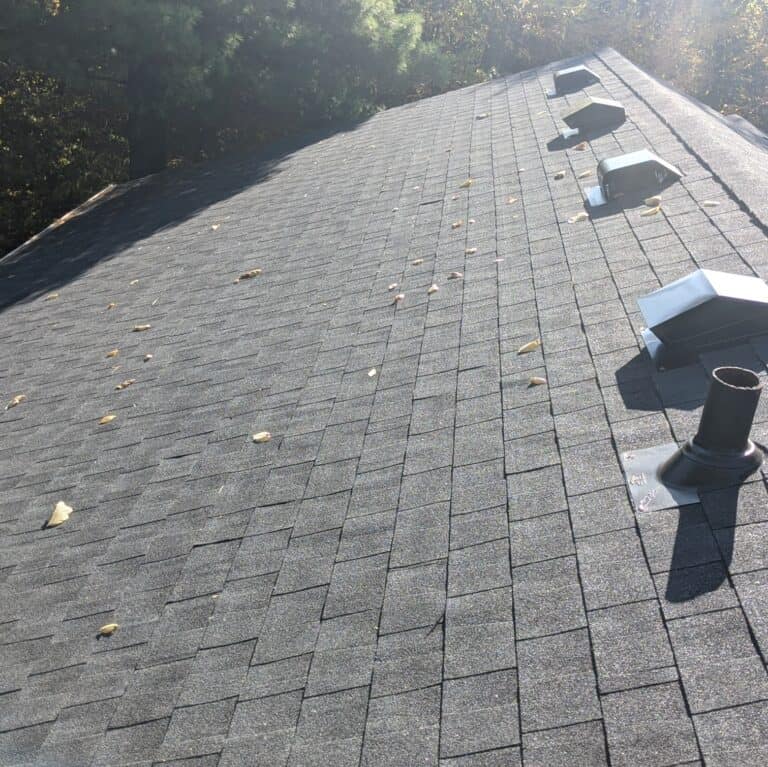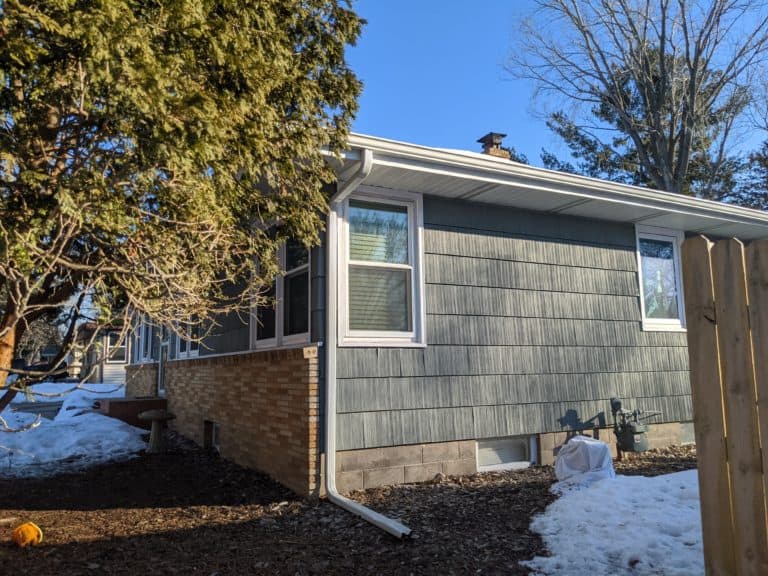To determine the number of roofing shingles needed, start by accurately measuring the total square footage of your roof. Include adjustments for any unique features like skylights or chimneys. Next, factor in the slope of your roof by using a pitch multiplier, which adjusts the basic area to account for the increased surface due to roof incline.
For standard installation, also add 10-15% extra material to cover potential waste due to cuts and breakage. Remember to consult manufacturer specifications regarding coverage per shingle bundle, based on the shingle type you select. There’s more useful insight available on optimizing your shingle purchase.
Key Takeaways
- Measure the total square footage of your roof to determine the base number of shingles required.
- Adjust your shingle estimate by adding 10-15% extra to account for waste and cutting errors.
- Check the manufacturer’s specifications to understand how many shingles are included per bundle and how much area it covers.
- Consider the roof’s pitch; steeper pitches require more shingles due to the increased surface area.
- Factor in additional features like skylights and chimneys, which may affect the number of shingles needed.
Understanding Roof Dimensions
To accurately determine the quantity of roofing shingles required, one must first thoroughly understand the roof’s dimensions, including its area, pitch, and unique architectural features. Key to this understanding is a precise assessment of the roof slope and roof angles, which greatly influence both the aesthetic and functional aspects of roofing.
The roof slope, or pitch, dictates the angle at which the roof rises from its edge to its peak. It is not merely a design element but an important factor that affects how well a roof sheds water and bears load.
A steeper slope generally means quicker water runoff and less accumulation of debris and snow, which can be vital in preventing structural damage during severe weather.
Equally important are the roof angles, especially in complex roof designs featuring multiple planes and gables. These angles determine how sections of the roof intersect and overlay, impacting how shingles need to be cut and laid for effective coverage and waterproofing. Understanding these angles helps in estimating more accurately the additional shingles required for overlapping, ensuring complete coverage without vulnerability to leaks.
Calculating Roof Square Footage
To accurately calculate roof square footage, it is vital to start by measuring the dimensions of the roof, including both the length and width of each plane. Next, factor in all roof features such as dormers, valleys, and chimneys, which can impact the total area and the quantity of materials needed. Precise measurement and consideration of these elements guarantee that estimations for shingles and other materials are accurate, avoiding shortages and excess in project planning.
Measure Roof Dimensions
Accurately measuring the dimensions of a roof is crucial for calculating its total square footage, which is crucial for determining the quantity of roofing shingles needed. Precise measurements guarantee that you select the appropriate roofing material options and apply roofing installation tips effectively, optimizing both performance and cost-effectiveness.
To begin, you’ll need a few essential tools: a sturdy ladder, a long measuring tape, and a helper if possible. Here’s how you can proceed:
- Measure the length and width of each roof plane: Each plane of the roof must be measured for its length and width. If your roof is not a simple rectangle, measure each section separately and record the dimensions.
- Calculate the area of each plane: Multiply the length by the width of each plane to get the area in square feet.
- Sum up the total area: Add the area of each plane together to get the total square footage of your roof.
This total square footage is crucial for the next steps in your roofing project, ensuring you purchase the right number of materials without excess, thereby maintaining economic and practical efficiency. Remember, accurate measurements are the foundation of a successful roofing job.
Include Roof Features
Considering roof elements like chimneys, skylights, and valleys is crucial when calculating the precise square footage for shingle requirements. These components not only impact the number of materials needed but also affect the installation process and the overall aesthetic of your roof design. To ensure precision, factor in the additional surface area that these features occupy and adjust your calculations to account for complex cuts and potential waste.
When selecting shingles, consider the roof slope and the specific material types that are best suited for your architectural design. Shingle colors can also be chosen to complement or enhance the visual appeal of your home. Here is a table illustrating common roof elements and considerations:
| Roof Element | Consideration |
|---|---|
| Chimneys | Adjust for extra flashing and cutting requirements |
| Skylights | Include additional shingles for sealing edges |
| Valleys | Calculate extra shingle overlap |
| Dormers | Factor in distinct roof sections |
| Hips and Ridges | Account for cap shingles and heightened durability needs |
Factoring In Roof Pitch
The importance of roof pitch in estimating shingle requirements cannot be overstated, as it directly influences the surface area exposed to the elements. To account for this, professionals must calculate the pitch multiplier, which adjusts the base square footage to give an accurate measure of the actual roof area. Once determined, this multiplier is essential for generating precise material estimates, ensuring both cost-effectiveness and adequacy in coverage.
Understanding Roof Pitch Importance
Understanding roof incline is important for accurately calculating the necessary quantity of roofing shingles. Roof incline, or the steepness of a roof, fundamentally influences how many shingles you will need because it affects the actual surface area of the roof. Unlike a simple flat surface, a slanted roof covers a larger area due to its diagonal spread.
Key points to keep in mind include:
- Roof Slope Calculations: Determining the slope of your roof is vital as it directly impacts the surface area calculations. A steeper roof will require more shingles to cover the same horizontal square footage compared to a flatter roof.
- Pitch Angle Measurements: Accurately measuring the pitch angle of your roof can help in estimating the additional surface area that needs to be covered. These measurements are important for ensuring you purchase the correct amount of materials.
- Practical Implications: Understanding the pitch helps in planning for other aspects such as underlayment and flashings, which are essential for a roof’s longevity and effectiveness in weather protection.
Grasping these elements not only ensures you have enough shingles but also aids in efficient planning and installation, thereby safeguarding your investment against common roofing challenges.
Calculating Pitch Multiplier
After grasping the importance of roof pitch, it becomes necessary to calculate the pitch multiplier to accurately determine the number of shingles needed.
The pitch multiplier is a critical factor that adjusts the base area of the roof to reflect the actual surface area, which increases with the steepness of the roof. This calculation guarantees that the quantity of shingles purchased is sufficient for covering the entire roof, without surplus or deficit.
To begin the pitch multiplier calculation, first measure the roof’s pitch, which is its slope. This is typically expressed as a ratio of the vertical rise to the horizontal run. For example, a common pitch might be 4:12, meaning the roof rises 4 inches for every 12 inches it runs horizontally. Each pitch correlates to a specific multiplier; steeper pitches require a higher multiplier.
Understanding the pitch multiplier is essential for effective roofing material selection. It directly influences how many shingles you’ll need, ensuring you neither under-buy nor waste resources. This precision in the shingle quantity calculation is not just about cost-efficiency but also about upholding quality and guaranteeing the durability of your roofing project. Remember, accurate measurements lead to better resource management and a smoother installation process.
Applying Pitch to Estimates
Considering roof incline is essential when estimating the correct quantity of roofing shingles needed for a project. The steeper the roof, the more surface area it covers, requiring more shingles for coverage. Accurately applying incline to your estimates guarantees that your project will have sufficient materials without costly overages or shortages.
When addressing roof incline in your calculations, consider these key points:
- Incline Adjustment Factor: Each roof incline has a corresponding multiplier that increases the base square footage to account for the additional surface area. For example, a 4/12 incline is less steep and might have a multiplier of 1.06, whereas a steeper 9/12 incline could be 1.25.
- Measurement Accuracy: Guarantee that incline measurements are precise. Even slight errors can lead to significant discrepancies in material estimates. Use reliable tools and techniques to measure the incline.
- Shingle Selection: Different types of shingles might perform better on specific roof inclines. Slopes that are particularly steep may require specialized shingles that adhere more securely to prevent slippage and enhance durability.
Types of Shingles and Coverage
Various types of roofing shingles differ significantly in their material composition, which directly impacts their coverage area and installation requirements. Selecting the right shingle materials is essential for both the durability and efficiency of the installation.
Asphalt shingles, for instance, are popular due to their cost-effectiveness and ease of installation. They typically come in strips that are easy to install and cover a standard area per bundle.
Metal shingles, on the other hand, although more costly, offer enhanced durability and weather resistance, making them ideal for areas prone to severe weather conditions. The installation techniques for metal shingles are more intricate and require professional expertise to make sure that the interlocking panels are properly secured.
The choice of shingle material also affects the overall lifespan and maintenance needs of the roof. Slate and ceramic shingles, while providing a high degree of weather resistance and a longer lifespan, also weigh more and may require additional structural support.
Homeowners must consider these factors—material types, installation techniques, weather resistance, and lifespan—when choosing shingles to guarantee optimal performance and durability of their roofing system, aligning with their desire for a lasting and low-maintenance solution.
Estimating Shingle Quantities
To accurately estimate the number of roofing shingles required for a project, homeowners should first calculate the total roof area and then consider the specific coverage provided by the chosen shingle type. It’s crucial to factor in elements such as skylights and chimneys, which may impact the overall shingle quantity. Proper planning ensures you purchase an adequate amount, while considering shingle color options can affect the aesthetic and functional value of your roof.
When estimating shingle quantities, consider these key factors:
- Measurement Precision: Accurately measure the length and width of each roof section, including additional features like dormers. Use these measurements to calculate the total square footage.
- Feature Considerations: Adjust your total shingle count to account for extra shingles needed around features such as skylights and chimneys. These areas require careful detailing and often more material.
- Shingle Coverage: Check the manufacturer’s specifications for coverage per bundle of shingles. This varies by shingle type and must be aligned with your roof’s total area to ensure complete coverage.
Estimating accurately not only optimizes your budget but also minimizes the likelihood of running short on materials, hence safeguarding your freedom to manage the project without unnecessary interruptions.
Planning for Waste and Extras
After estimating the required amount of shingles, it is equally crucial to plan for extra materials to accommodate potential waste and unforeseen needs during the roofing process. Waste management is a vital component of any roofing project, not only to guarantee efficiency but also to maintain budget considerations. It is recommended to add an additional 10-15% to your total shingle estimate to cover cutting errors, breakage, and unforeseen adjustments.
Ordering extras is not just about having additional shingles on hand; it also involves strategic preparation for any scenario that might arise during installation. This foresight allows for continuous work without delays, preserving both time and resources.
Furthermore, consider the storage solutions for these extra materials. Proper storage is essential to prevent damage and degradation of shingles before they are used. Make sure that the storage area is dry, shaded, and well-ventilated to keep the shingles in prime condition.
Frequently Asked Questions
Can I Install New Shingles Over Old Ones?
Installing new shingles over old ones can offer cost savings and is feasible if the underlying layer is intact, potentially extending the overall shingle lifespan. However, assess for structural integrity and weight capacity first.
How Does Weather Impact Shingle Installation Timing?
Weather greatly influences shingle installation, as scheduling must account for potential weather delays. Proper timing prevents material expansion and contraction, ensuring a seamless installation and long-term durability of your roofing project.
What Are the Best Shingles for High Wind Areas?
For high wind areas, selecting shingles with enhanced wind resistance and durability is essential. Opt for architectural or asphalt shingles specifically designed to withstand extreme conditions, ensuring long-term protection and reduced maintenance needs.
How Long Does Shingle Installation Typically Take?
Shingle installation typically spans 1 to 3 days, contingent on effective time management and project planning. Employing efficiency techniques can streamline the process, mitigating labor costs and ensuring technical accuracy for long-lasting performance.
Are There Eco-Friendly Shingle Options Available?
Yes, eco-friendly shingle options are available, utilizing sustainable materials that enhance energy efficiency. These options contribute to environmental conservation while potentially reducing energy costs, aligning with values of freedom and sustainability.
Conclusion
To sum up, the precision in measuring roof dimensions and calculating square footage stands in stark contrast to the unpredictable challenges posed by varied roof pitches and shingle types. This meticulous planning is essential for accurate shingle estimation, seamlessly blending the theoretical mathematics with the practical realities of roofing.
By incorporating allowances for waste and additional materials, one maintains a harmonious balance between exactitude and the exigencies of construction, safeguarding against both shortfall and excess.





